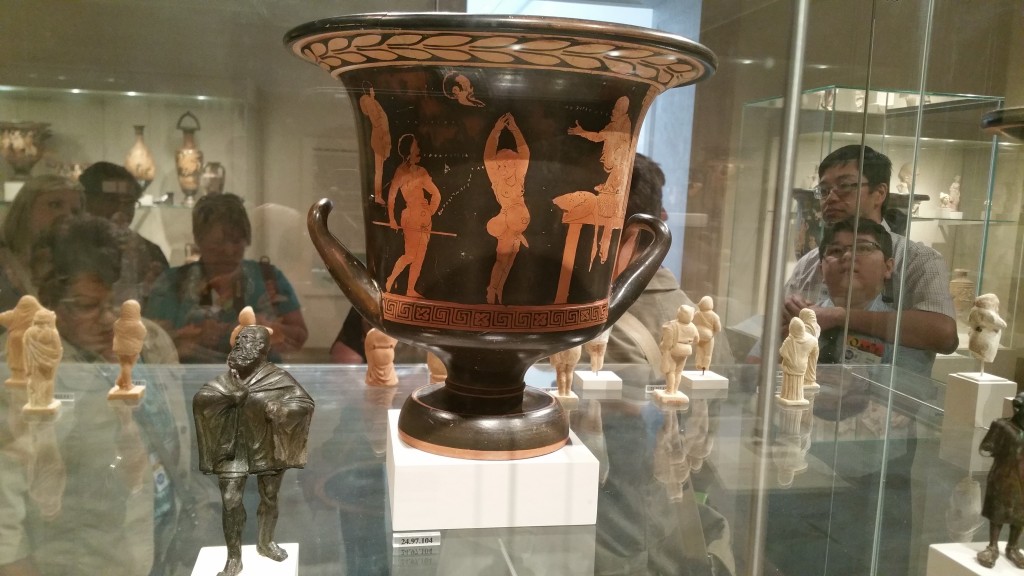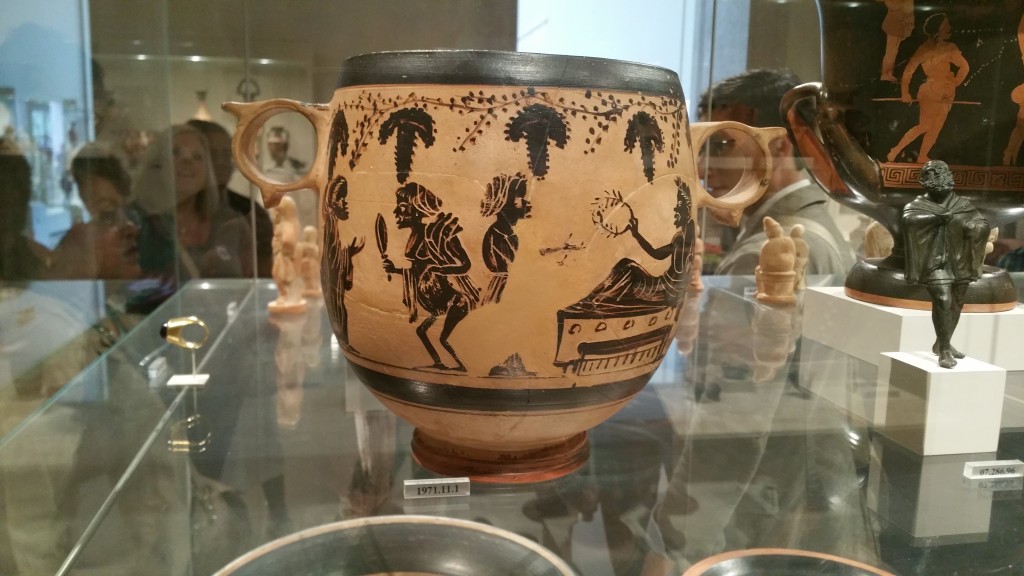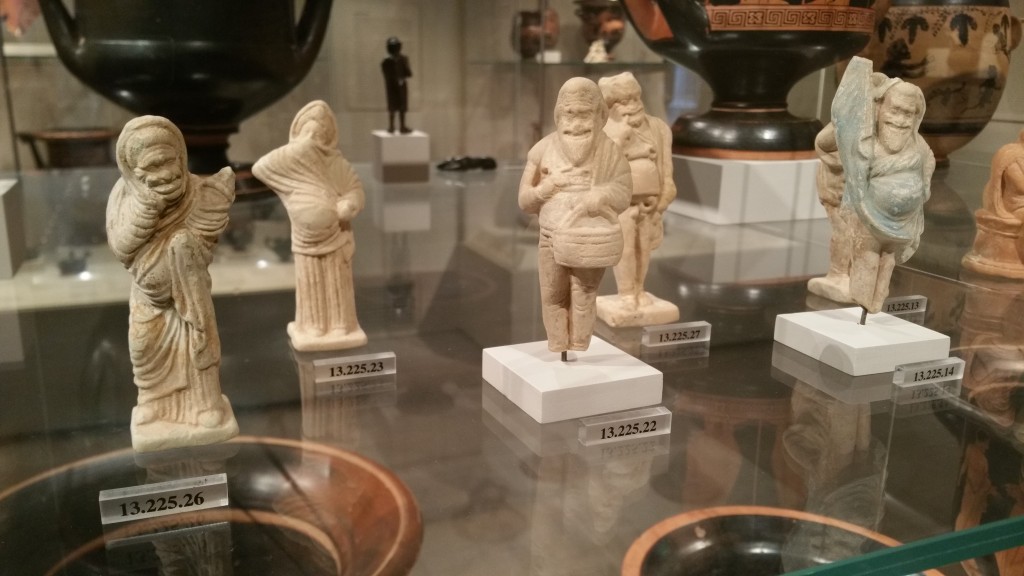David Choi
Dr. Brian Rhinehart
THR 503 – Theatre History I
October 11, 2015
MET Museum Assignment
I visited the Met on September 12, 2015, entering the Greek and Roman exhibition area first. I split with the group I arrived with and gravitating to a hyper-buoyant tour guide (likely a thespian himself), I hitched a ride with his group of tourists from Spain. That was a good move because he brought me to the one area that fascinated me the most – the Greek Theatre museum pieces.
- Terracotta calyx-frater (mixing bowl)
- Greek, South Italian, Apulian, red-figure, ca. 400-390 BC
Attributed to the Tarporley Painter
Obverse, scene from a phlyax play
Reverse, three youths
“The representation shows the structure of a stage at the far right. A hag with a dead goose and a basket containing a kid proclaims something to the effect of “I shall hand him over.” An old man with arms raised pirouettes stage center. Looking to his right, he says, “He has tied my hands up high.” The actor with a long staff wears the costume of a nude figure and probably is the caricature of an athlete; his garments are thrown over the shoulder of the small figure at the upper left. The inscription associated with the athlete makes no sense and has been considered a magic spell responsible for the raised arms of his neighbor. Above the “athlete” is the word “tragedy,” and a mask hangs in the background. A recent interpretation makes the two male figure accomplices about to steal the hag’s provisions or defy her threats to turn them in. The inscriptions, written in Attic Greek, indicate that this farce originated on the Greek mainland rather than in Southern Italy.” - The bowl shows a scene from a phlyax play. A Phlyax play (Ancient Greek: φλύαξ, also phlyakes), also known as a hilarotragedy, was a burlesque dramatic form that developed in the Greek colonies of Magna Graecia in the 4th century BCE. These were farces/parodies with elements of a tragedy, or in the manner of serious works. I personally love the dark comedy style of films like A Clockwork Orange, The Royal Tannenbaums, Election, Fargo, Officespace, Being John Malkovich, Django Unchained, Snatch, Pulp Fiction, American Beauty, Fight Club, Trainspotting, Fear & Loathing in Las Vegas, Adaptation and more. If I could choose the type of films/plays that I could be a part of in future years, it would be dark comedies, hands down.
- So they say this is a mixing bowl – I wonder how much something like this went for? I imagine that these were made to promote a particular play that was going on at the time. The choregus, or producer, would likely have wanted to either sell these to gain favorability in competitions. This is clearly some of the earliest forms of branding and marketing for plays.
- Terracotta skyphos (deep drinking cup)
- Greek, Boeotian, black-figure, mid-4th century BC
Closely related to the Vine Tendril Group
Obverse, reclining man and three crones (the Judgment of Paris?)
Reverse, ogress pursuing three pygmies
“The Kabirion is a sanctuary on the outskirts of Thebes in Boeotia dedicated to the Kabiroi, deities associated with fertility and the sea. Their cult included mysteries whose introduction is ascribed to the goddess Demeter. A distinctive variety of pottery, known as Cabiric vases, was produced from the late fifth through the late fourth century BC. This example is characteristic in subject and technique. Such works may reflect farces performed in conjunction with the mysteries. They are contemporary with representations of Middle Comedy and the phlyax vases.” - I was inclined to this piece because it represented comedy and mystery on a beer/wine mug. It so happens that I have a love affair with comedy (and mystery) and inebriation (the latter, formerly). In all my research and self teachings, I realize that as much as professors, scholars and scientists would like to believe that we are on our way to solving life’s greatest mysteries, I believe the great answer to the great riddle will forever be just outside of our reach. No matter how far we get in space and beyond, there will always be new frontiers for science and follies of man to learn from. Imho, there was never meant to be a theory to fit everything so the big joke is actually on us (but first on Einstein and the likes of him). And all this serves an excellent purpose – to keep us humans striving for more – more mystery, more trials for solutions and more comic relief (because what a chore this would all be if we didn’t have someone to laugh at/with).
- Group of fifteen Terracotta comic actors
- Period: Late Classical
Date: late 5th–early 4th century B.C.
Culture: Greek
Medium: Terracotta
Dimensions: H. 3 13/16 in. (9.7 cm)
Classification: Terracottas
“Fourteen of these figures are said to have been found together in a burial in Attica. They are among the earliest known statuettes of actors and are superbly executed and preserved. Originally they were brightly painted. They document the beginning of standardized characters and masks, indicating the popularity not of a specific figure but of types—the old man, the slave, the courtesan, etc.—that appeared repeatedly in different plays. By the mid-fourth century B.C., Attic examples or local copies were known throughout the Greek world, from Southern Russia to Spain.” - These figurines were likely sold by theatrical companies as souvenirs and helped to standardize these comic characters, made famous by Aristophanes – the hag, the old man, the slave, the courtesan, etc. They became instantly recognizable with the help of these ancient versions of modern day Bobble-heads. Here again we see the commerce of such action figures helping to drive the pervasiveness of theatre art. Having my undergraduate studies in Economics and Anthropology at NYU, this serves as a prime example of the driving forces of economics and culture feeding each other through the evolution of human civilization.


